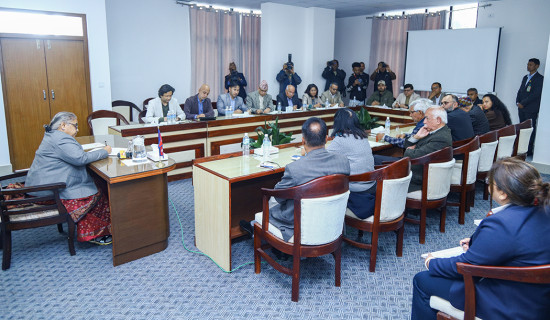- Monday, 17 November 2025
Nepali ancestry traced to South and East Asia
Kathmandu, Oct. 22: Most Nepalis have derived their maternal ancestry from South and East Asia, an international team of researchers have found. As per the team, led by Dr. Kumarasamy Thagaraj of India’s Council of Scientific and Industrial Research (CSIR)-Centre for Cellular and Molecular Biology (CCMB) and Dr. Tilak Ram Shrestha of Nepal’s Tribhuvan University (TU), an analysis of the mitochondrial DNA of Nepal’s various ethnic groups revealed South and East Asian lineages.
The team analysed the DNA sequence of 999 individuals belonging to different communities of the country, including Newa, Magar, Sherpa, Brahmin, Tharu and Tamang, living in Kathmandu and eastern Nepal and published their findings on Saturday in the journal Human Genetics.
“This is one of the largest studies into the Nepali population,” claimed Thangaraj, who is presently the director of the Centre for DNA Fingerprinting and Diagnostics in Hyderabad. “And this helps us understand where we came from,” added Rajdip Basnet, first author of the study from Tribhuvan University.
The results obtained from this study help researchers fill several critical gaps about the history and past demographic events that shaped the present Nepalese genetic diversity, a statement provided by the scientists to The Rising Nepal read.
Further explaining the significance of the results, Basnet said, “Our study shows that the ancient genetic make-up of Nepalis was gradually transformed by the various mixing episodes that occurred along our ancestors’ migratory path to Nepal.” He added, “The carriers of some mitochondrial lineages may have crossed the Himalayas into Nepal – most likely via Southeast Tibet – between three-and-a-half and six thousand years ago.”
This study took a special look at the Tibeto-Burman communities of the country and found that Sherpas displayed the highest frequency of east Asian ancestry in their DNA at 94.3 per cent. This was followed by the Tharu community of Chitwan at 68.4 per cent, then by Tamangs at 65.9 per cent, Magars at 54 per cent and by the Newas at 51 per cent.
“The genetic diversity and the cultural ties Nepal shares with India, China (Tibet) and East Asia is reflected in our DNA,” said Dr. Shrestha.
Basnet said that the team planned to publish further articles in the future which would detail the ancestry of other ethnic groups of the country. Similarly, he said that the present article only outlined the maternal ancestry because the mitochondrial DNA it based its research on is only passed down by mothers.
Meanwhile, Dr. Krishna Das Manandhar, head of TU’s Central Department of Biotechnology, hoped that such studies would help us understand the genetic diversity of the Nepali population and establish the genetic affinities of populations across South Asia for a better understanding of early human migration.
Being a unique trade route linking South Asia with Tibet and other regions, experts have long believed Nepal to be an ideal country to study to understand south and east Asian genetic ancestry. Yet, to date, little is known about the population history of this region. Hopefully, this study changes that, stated the researchers in their statement.













